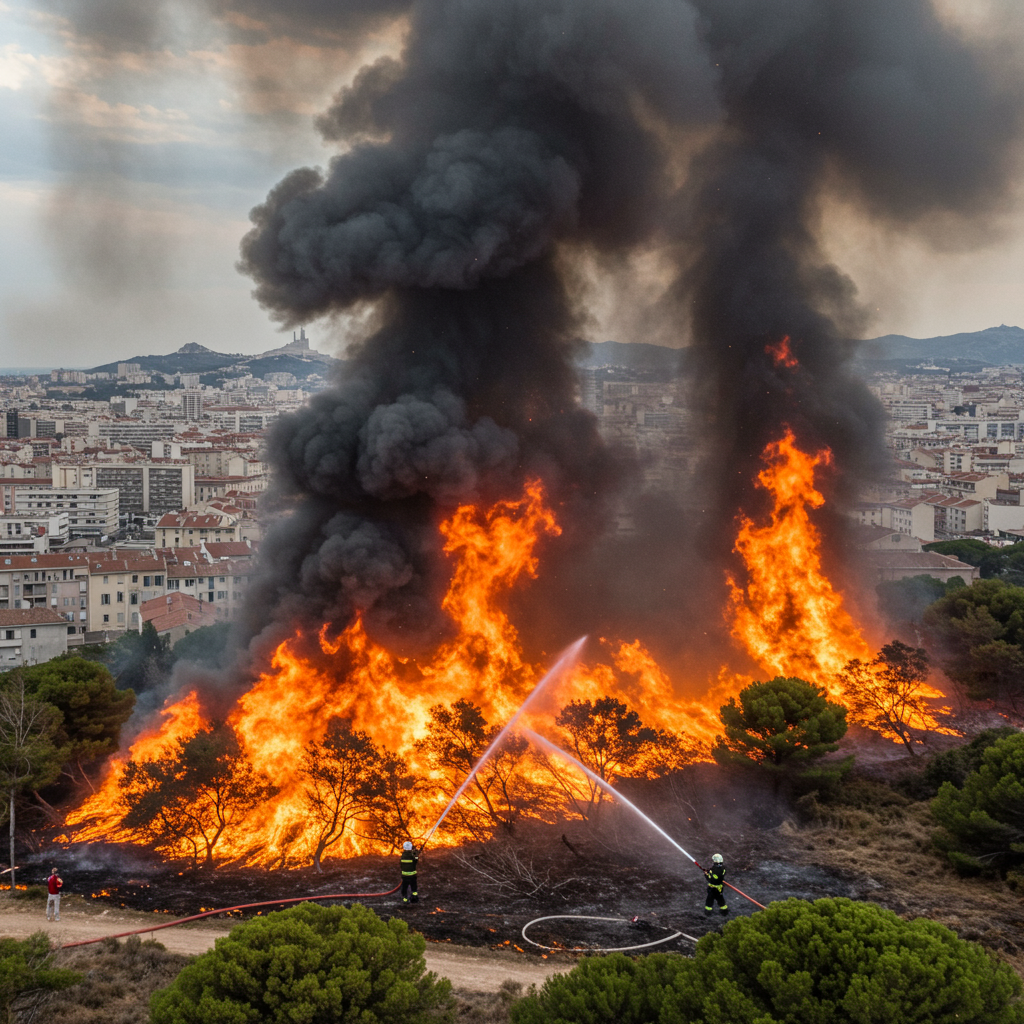A rapidly spreading wildfire poses an urgent threat as it pushes towards the outer boundaries of marseille, France’s bustling second-largest city. Emergency services are engaged in a fierce battle against the blaze, which has already forced residents to flee and disrupted essential infrastructure.
The fire ignited near Pennes-Mirabeau, a community located just north of Marseille. Fueled by challenging conditions, the flames have consumed a significant area, estimated by local authorities to cover approximately 700 hectares, equivalent to about 7 square kilometers. This rapid expansion has brought the destructive power of the wildfire perilously close to urban areas.
Emergency Response Mounts Against the Flames
Responding to the escalating crisis, firefighters are deploying extensive resources. The dedicated marine firefighter battalion based in Marseille is on the front lines. Mayor Benoît Payan described their intense efforts vividly, stating they were “waging guerrilla warfare, hoses in hand,” highlighting the challenging and direct nature of their fight against the fire.
The prefect of the Bouches-du-Rhône region, Georges-François Leclerc, reinforced the gravity of the situation, emphasizing that firefighters were actively “defending” the city itself. He issued a strong recommendation for local residents to remain indoors as a safety precaution. While acknowledging that the situation remained dynamic and not static, Prefect Leclerc conveyed that the blaze was currently “under control.” Interior Minister Bruno Retailleau was scheduled to arrive in Marseille later in the day to assess the situation firsthand.
Over 700 firefighters, supported by around 220 vehicles, have been mobilized to combat the fire’s advance. Fire engines work on the ground, while helicopters and planes are utilized from the air to douse the flames and slow their spread. The sheer scale of the deployment underscores the severity of the threat facing the region.
Significant Disruption Across Marseille Area
The wildfire’s proximity has triggered immediate and significant disruptions for residents and travelers alike. Marseille Provence Airport was compelled to close for the remainder of the day, impacting air travel to and from the region. The airport’s president, Julien Coffinier, commented on the unprecedented nature of the event, stating he had “never experienced a situation of this magnitude” during his tenure.
Authorities have issued clear safety directives to those in affected areas. Residents are strongly advised to stay inside their homes, closing all shutters and doors to prevent smoke and embers from entering. A crucial instruction is to keep roads entirely clear. This measure ensures that emergency service vehicles, such as fire engines and ambulances, can move freely and quickly to where they are needed most, without being hampered by civilian traffic.
The threat to homes has already led to compulsory evacuations. Local authorities confirmed that several dozen people have been ordered to leave their residences for safety. The sudden need to evacuate, coupled with official advice to limit movement, resulted in dense traffic jams on roads as some residents attempted to leave the city or surrounding areas, adding another layer of difficulty to the crisis. Footage shared widely online depicted vast plumes of thick smoke billowing into the sky above Marseille, painting a stark picture of the fire raging in the hilly terrain just to the north.
Tracing the Cause and Fueling Factors
Investigators quickly identified the likely origin of this destructive blaze. According to local authorities, the fire was sparked by a car that caught fire on a motorway near Pennes-Mirabeau earlier on Tuesday. While car fires can occur, the subsequent rapid and widespread ignition of surrounding vegetation points to critical environmental conditions.
A major factor exacerbating the fire’s spread is the weather. Strong winds are a significant concern, expected to continue blowing until late in the evening. These winds fan the flames, pushing them across dry land at an accelerated pace, making containment efforts substantially more challenging for firefighters. The Bouches-du-Rhône area, like many parts of Southern Europe, has been experiencing a prolonged period of dry weather. French broadcaster BFMTV noted that the region had not recorded a single drop of rain since May 19th. This extended drought has left vegetation incredibly dry and combustible, creating a perfect environment for wildfires to ignite and spread rapidly when exposed to a spark, such as the car fire. The combination of tinder-dry conditions and persistent strong winds creates a highly volatile situation that fire crews are battling against.
Local Voices and Broader European Context
The human impact of the fire is profound, particularly for those living in the immediate vicinity. Residents in towns bordering the affected area have expressed their fear and shock. Monique Baillard, a resident, shared her powerful impression with Reuters news agency, describing the scene as “very striking – apocalyptic even.” She added that many of her neighbours had already decided to leave their homes rather than wait. These firsthand accounts underscore the terrifying speed and visual intensity of the approaching flames and smoke. Local residents who spoke to French television channels also reported the difficulties caused by dense traffic as people attempted to navigate away from the danger zones.
The wildfire near Marseille is not an isolated incident but part of a wider pattern affecting Southern Europe. The region has recently endured a scorching early summer heatwave, leading to exceptionally dry conditions across multiple countries. This has unfortunately resulted in numerous significant wildfires breaking out, prompting thousands of evacuations and stretching emergency services thin across the continent.
In France alone, another substantial wildfire has been active near Narbonne, in the Aude department, since Monday. Fanned by winds reaching speeds of 60 km/h (approximately 40 mph), that fire has already consumed about 2,000 hectares, according to local officials. This simultaneous large-scale fire highlights the national strain on firefighting resources.
Spain is also grappling with severe wildfires, particularly in the Catalonia region of the northeast. A major blaze in the eastern province of Tarragona has been a significant concern. This fire prompted authorities to order over 18,000 people to remain indoors as a safety measure. The Tarragona fire has spread across nearly 3,000 hectares (over 7,400 acres) and has been particularly challenging to control due to high overnight winds, some reportedly gusting up to 90 km/h (56 mph), which made firefighting efforts “precarious” and “very difficult” as described by experts. Experts warn that high fire risk across Spain this year is linked to dense vegetation growth from heavy spring rains quickly drying out under intense summer temperatures, following Spain’s hottest June on record. Several other areas across Spain remain on high alert for potential fire outbreaks due to these conditions.
Greece has also faced a spate of wildfires. On a single Monday, some 41 fires were reported across the country. While many were quickly brought under control, seven remained active into the evening. These widespread incidents underscore the vulnerability of the Mediterranean region to wildfires during periods of intense heat and drought, conditions increasingly linked to climate change. The scorching heatwave that hit much of western and southern Europe created the tinder-dry environment that allowed these fires to ignite and spread with alarming speed.
Frequently Asked Questions
What is the current situation with the Marseille wildfire?
As of recent reports, a rapidly spreading wildfire has reached the outskirts of Marseille, France. The blaze originated near Pennes-Mirabeau and has burned around 700 hectares. Authorities state the situation is “under control” but remains dynamic. Emergency services are intensely working to prevent its spread into the city itself.
What advice have residents near the Marseille fire been given?
Authorities have strongly advised residents in the affected areas to stay indoors, keep shutters and doors closed to protect against smoke and embers, and ensure roads are kept clear for emergency vehicles. Several dozen people have been evacuated from their homes as a safety measure.
What caused the wildfire near Marseille, and why is it spreading?
Local authorities attribute the fire’s ignition to a car that caught fire on a motorway near Pennes-Mirabeau. Its rapid spread is primarily fueled by strong winds, expected to continue until late evening, pushing the flames across the dry landscape. The Bouches-du-Rhône region has experienced a significant drought, with no rain recorded since May 19th, leaving vegetation extremely dry and susceptible to fire.
Conclusion
The wildfire threatening Marseille represents a serious and immediate challenge for French emergency services and residents. While officials indicate the situation is under control, the combination of strong winds and extremely dry conditions creates a volatile environment where the risk of further spread remains high. The scenes of smoke and evacuation are a stark reminder of the power of wildfires, particularly when amplified by environmental factors like drought and wind. This event also highlights the broader vulnerability of Southern Europe to such blazes, a consequence of recent heatwaves and changing climate patterns that are contributing to drier conditions and increased fire risk across the Mediterranean region. Efforts to contain the fire and protect the city are ongoing, with authorities urging continued vigilance from the public.



